Women's Experiences of Birth in St. Petersburg, Russian Federation, Following a Maternal and Child Health Intervention Program
This study was supported by a grant from the Canadian International Development Agency (Number 30133), Toronto, Ontario, Canada.
Abstract
Background:
An educational program for professionals in maternal and child health care in St. Petersburg, Russian Federation, was conducted between 1994 and 1997.
Methods:
The program was designed to provide 12 workshops in evidence-based antenatal and intrapartum care, and appropriate preparation of parents for pregnancy, birth, and parenthood for health care professionals in the city.
Results:
Observations on the quality of maternity care service provided for women at the start and after the completion of the intervention program are reported. Significant changes occurred in maternity care practices during the period in which training programs were offered in St. Petersburg. In particular, more family centered care services were introduced, and breastfeeding practices improved. Significant reductions in maternal and perinatal mortality occurred.
Conclusions:
Most maternity hospitals showed a reduction in the use of interventions in delivery over the period of study, although one or two showed tendencies to follow in their Western counterparts' footsteps, including the emergence of a high cesarean delivery rate. This is not yet a cause for concern, but is worth future monitoring by local authorities. (BIRTH 25:2 June 1998)




